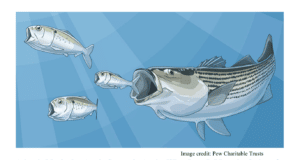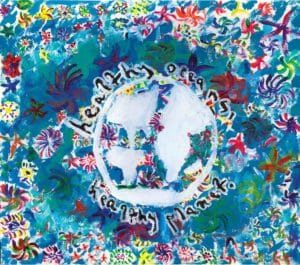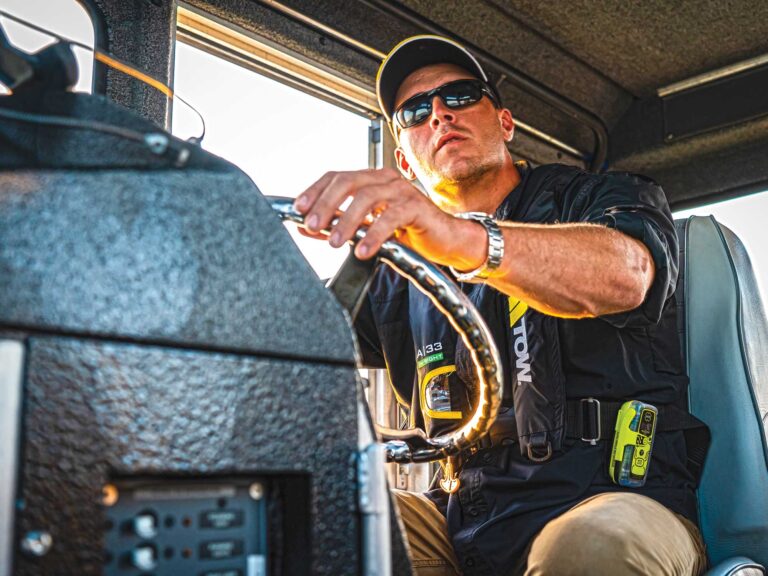I’m performing an unnatural act that, although enjoyable, is creeping me out. And I’m not alone in feeling this way. It happened to many of us this past winter.
• I’m in my boat, the pelicans are diving, the fish are biting, and the occasional spray of cool bay water feels delightful on my sun-warmed skin. I’m in the middle of one of the best striper runs in decades. There’s just one problem: It’s not supposed to be like this. Not right here, not right now. It seems as if nature has gone all bizarro – because I’m enjoying this wonderful day in mid-January on the Chesapeake Bay. By all rights, the fish I’m after should be far to the south while my boat resides under shrink-wrap.
• Those of us who were slow to put our boats away last fall enjoyed the longest boating season the East Coast has ever seen. November and December were unusually mild, and January was downright hot. The hottest on record for many areas up and down the seaboard. Creeks remained ice-free, fish and waterfowl were months behind schedule on their usual fall migrations, and boating in some places was possible – even pleasurable – right up to the week before Groundhog Day. Weird.
Just the Facts, Ma’am
Things are warming up – and have been for quite a while. That’s a fact. But what remains questionable is whether that’s due to cow flatulence or the output from your SUV. If you want to know what’s causing global warming, listen to AM talk radio while watching An Inconvenient Truth and simultaneously running a Google search. We’ll stand back and watch as your head explodes. You’ll get more contradictory “science” and misinformation than you would from listening to Honda salesmen having a two-versus-four-stroke debate with the E-Tec PR team. So we’re not going to touch the “what’s responsible” question with a 10′ boathook. We’re just going to stick to the facts as we know them.
Fact: Last August a manatee from Florida was sighted in the Hudson River off New York City.
Fact: The 2006 average annual temperature for the contiguous United States was the warmest on record and nearly identical to the record set in 1998, according to scientists at the NOAA National Climatic Data Center.
Fact: Marine migrations have gone haywire:
• There was a winter striper run in the Chesapeake. • Croaker are now commonly found in northern New Jersey, where they were previously thought of as rare. • Tropical lionfish have been found as far north as the Long Island Sound and have established solid populations as far north as North Carolina. • Runs of squid on the Pacific coast are becoming more common and are reaching farther north. • Cobia, once thought of as a southern sportfish, have been turning up as far north as New York, with more showing up each year.
Fact: From the EPA: • Since the mid-1970s the average surface temperature has warmed about 1°F. • The Earth’s surface is currently warming at a rate of about 0.32°F per decade or 3.2°F per century. • Worldwide, the five warmest years over the last century have been 2005, 1998, 2002, 2003, and 2004. The top 10 warmest years have all occurred since 1990.
Fact: The Pentagon’s paper “An Abrupt Climate Change Has Substantial Implications For U.S. National Security” opens by stating, “Substantial evidence exists to indicate significant global warming will occur in the 21st century.” We don’t know why our climate is getting warmer, but it is. This could be bad, good, or nothing at all. But it’s here, so let’s make the most of it.
Endless Summer?
Okay, so things are heating up. What does that mean to us as boaters? The first and most dramatic difference will probably be in the way you winterize – if you do at all. If 2007 was any guide, we’d suggest putting off winterizing until the very last minute. For those in the Northwest, Midwest, Northeast, and mid-Atlantic, there have always been certain months that boaters have written off as being too cold. The way things are going, these lost months could now provide you with great weather. In some areas you may not want to winterize at all.
Instead of considering the winter as being a “total downtime,” think of it as “brief periods of inactivity.” For many of us, hauling the boat will be less of an imperative. And instead of a full winterization regime, just taking the immediate measures necessary to prevent freeze damage may be enough. For example, you could just cover the cockpit so snow or ice doesn’t clog the scuppers and sink the boat. Or leave a high-watt lightbulb burning in the bilge to keep things warm. In all likelihood you’ll still have to drain your freshwater systems and winterize the head; because they’re above the waterline these systems can freeze in a hurry. But there’s no reason why your boat can’t remain in the water or on a trailer ready to go.
If you have an outboard, you’re in luck. Most of the winterizing process for an outboard is routine maintenance (changing lower unit oil, replacing spark plugs, and so on) and you should obviously continue these practices. But tell your mechanic to skip fogging the cylinders. When those warm winter days roll around, you’ll be ready to go at the turn of a key. Just make sure that once every two weeks, whether you’ve been boating or not, you run the motor until it warms to its running temperature. This will drive out moisture, circulate the oil, and keep the internals lubricated.
If you have an inboard or generator, its raw cooling water has to be displaced with antifreeze. It’s a matter of putting the intake hose into a container of antifreeze and running the engine. Rather than take the hose off the seacock, it’s easier to permanently install something like the FlushPro winterizing system from Perko (www.perko.com).
Most stern drives get their cooling water from the lower unit, which holds on to some water after being shut down. To replace the water with antifreeze, try Camco’s DIY Boat Winterizer (www.camco.net). ****
Warming to the Subject
Being out on the water in what used to be the off-season will require a bit of special attention on your part. In areas that usually get clogged with thick ice, the Coast Guard changes some buoys over to “spar” buoys, because ice can’t get a grip on these thin, stick-like markers. The Coasties will no doubt keep making the changes for a long time, but it may throw you off if you’re looking for the can or nun buoy you knew in the summer.
And let’s not forget about fuel. Boating in the off-season is a good thing when it comes to ethanol, which most often causes problems after sitting in the tank for months at a time. By using up that fuel and replacing it with fresh stuff, you’re less likely to have issues. But ask at the local fuel dock before you assume it’ll be open in the middle of December. If it takes your marina a while to catch on to this warm winter boating trend, you may need to work out an alternate fuel delivery system. That may be as simple as hauling fuel cans, or using a large rolling tank such as the 30- and 100-gallon models from Tempo (www.tempoproducts.com).
If you have a big boat, you’ll probably need to schedule a fueling appointment with the marina ahead of time, or find one that remains open during the off-season to service commercial vessels. A good resource for finding winter gas docks is your local towboat operator such as Sea Tow or TowboatUS. Most stay on active duty all year, shutting down only for the worst of the winter.
The Three-Season Angler
Another major way the shift in the weather will affect us is where and when we go fishing.
In some areas, global warming will have a negative impact. According to the National Resources Defense Council, cool-water fish such as salmon and trout face habitat reduction of 10 to 38 percent in the coming decades. The Florida Wildlife Federation says that rising sea levels will flood marshlands, which are breeding grounds. This will affect such popular species as redfish, speckled trout, tarpon, gag grouper, and flounder. Plus, red tides are expected to increase.
A quick glance at historical records shows that at least one major environmental change has already occurred in the Gulf of Alaska. Over the past few decades a “trophic regime shift” has taken place. That’s the scientific way of saying that warming conditions have caused marine populations to seriously whack out. From the 1950s to the 1980s, shrimp, crabs, and herring were the most common species in this region. But an ever-so-slight warming caused a change in the base of the food web, with a shift in the dominant species of plankton. This seemingly insignificant change worked its way right up the food chain, and during the 1990s the most common species became cod, pollock, and halibut. We’re not sure what the ramifications of this are, but it’s a drastic change. And this isn’t the only change that’s been detected at the base of the food web. There have been significant alterations in the populations of North Atlantic krill – tiny shrimp-like animals – that a lot of species depend on as their food source. Then there’s a Pentagon memo that notes that the North Atlantic is being freshened due to melting glaciers and increased precipitation. Hmmm…wonder if that might have an effect on the fish that swim there?
From an angler’s standpoint, the changing climate means several things. Our best advice: Be ready to change your target species and your fishing tactics. You might discover entire new fisheries exist where they didn’t before. During the summer months, when rising temperatures can make fishing both uncomfortable and unproductive, consider taking the boat out after dark and going night fishing. You’ll discover that in many cases, the fish are more active. During the day, look for cool water areas that may be found where there are deep holes, current upwellings, or underground springs.
What can you do to combat global warming? Maybe nothing – it may be out of our hands. Or maybe not. Even if all the rightwing nut jobs are right about the leftwing loonies screaming about doom and gloom, it can’t hurt to cut back on wasting fuel and reduce emissions. It’s a decision you might want to take time to wrestle with as you fuel up to go wakeboarding on GroundHog day.









